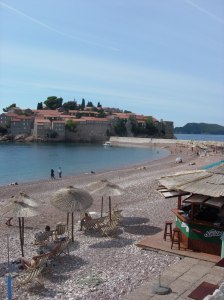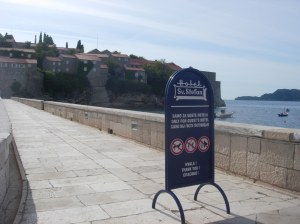 In a little cove on the Montenegro coast, cleaved between staggers of rock and water clear as glass, I’ve discovered what is simultaneously the most beautiful and depressing place I’ve never been: Sveti Stefan.
In a little cove on the Montenegro coast, cleaved between staggers of rock and water clear as glass, I’ve discovered what is simultaneously the most beautiful and depressing place I’ve never been: Sveti Stefan.
A little jumble of terracotta roofs, grey stone buildings that look like they were carved right out the rock, a couple trees poking through, all sitting plump and pretty and perfect in that glittering, glittering water: what could be more picturesque?
So you take pictures. Lots of them. You see the other vacationers—Eastern Europeans and a handful of Italians—doing the same. You’ll go over, have a stroll, feel the old cobbled stones through your soles, soak in the Old World ambiance before you work on that sunburn you’ve been itching for.
Only you can’t. You can’t actually go in Sveti Stefan. On the narrow isthmus leading up to the island—made of sand and reinforced with a stone-wall walkway—there’s a sign telling you you can’t. And a security guard, to remind you. And another one at the end of the isthmus (you can see him down there, pacing dutifully).
This is because the entire town is a resort. The entire town.
I hadn’t actually grasped that part in the guidebook: “an old fishing village that was nationalized in the 1950s and turned into a resort…” The resort was closed, but scheduled to reopen; in the meantime, a township had sprung up onshore, keeping the beaches alive with the gentle buzz of non-corporate tourism. All of which promised to change the moment the resort reopened—so go while you can, I read between the lines.
I envisioned a monstrous, skeletal structure with workcrews hanging from cranes, somewhere off to the side of an idyllic pebble beach—an eyesore, but something you could turn your back to. I did not picture the entire island, the remains of a 15th-century village, privatized and closed off to the public.
It’s like a modern-day version of a Forbidden Island. But instead of pirates burying the booty, it’s luxury travel mongols.
Sitting in the sand, under one of the umbrellas Boris the hotel worker graciously has let you set up camp beneath (hey, it’s October, officially low-season), you feel a little like a grubby kid with their nose pressed up to the glass of some fancy restaurant. It’s a pathetic feeling of alienation—you mean I can’t even walk in there?—that surprises you.You watch a small boatload of people disembark. The gentle breeze carries their posh British accents over your way; you watch them climb the steps in a wave of white scarves and sun hats. They’re greeted by some resort offical and whisked off down the isthmus, a bagpipe player gloriously leading the way. You pick some pebbles off your leg and feel more dejected.
There’s a story there, and you know it. You imagine some 60 years ago, a traditional, working-class town filled with fishermen and their families. You imagine the boats going out in the morning, the nets coming back full in the afternoon; you picture the women in aprons calling from the windows at their children, running down narrow lanes. You picture them all forcibly removed from their homes, uprooted and unearthed after 500 years, and not able to return home. Because wealthy people wanted to work on their sunburns.
Such displacement happens in the world, yes, but usually in the name of war, religion, apartheid. But tourism?
 You wander over to the shady terrace of a fancy cafe for an overpriced espresso. It’s killing you—the story, the story hiding in there, that you can see but can’t get into—so you ask the guy serving you your coffee. He gives you the Disney version. Afterall, he works for the resort.
You wander over to the shady terrace of a fancy cafe for an overpriced espresso. It’s killing you—the story, the story hiding in there, that you can see but can’t get into—so you ask the guy serving you your coffee. He gives you the Disney version. Afterall, he works for the resort.
The town’s population had been dwindling, and, in the 50s, the government bought out the last remaining families—15 or 16, who were given “nice pieces of land” in exchange. The town was then turned into a resort—“the only town resort in the world,” he says with a puff of pride—and saw the likes of Hollywood celebrities and European royalty. Then, “alas,” during the wars of the 90s, the resort fell into disrepair.
But “thankfully,” a German company interveened and purchased the resort. They made a series of exhaustive, tasteful renovations that manage to “retain the Mediterranean charm.” (“It’s really very excellent.”) The resort will officially reopen and accept guests sometime within a year—the British people I saw were probably on a promotional tour.
“Are there ever any other kind of tours? Like for the public?”
“No, no. It is closed. It’s not so nice—you pay to come to a place and have tourists outside your window all day.”
I nod slowly, thinking of a comment I heard once about why private schools should have tuition: “otherwise all the poor people would come rushing in.”
“But, maybe, I don’t know,” the espresso server continues, “you are here for awhile,” shrugs, “maybe I can work some magic, get you a tour.” He sneaks a sidelong glance.
The writer in me wants to press. The feminist in me wants to puke.
I sit there, instead, and watch the island, the steeple from the old church peeking up above the roofs and the green of its remaining trees. I watch the water nod in white glimmers and think, “Yes, yes, there’s a story there.” If I could just get in, if I could just walk among its buildings, sit on its stones, I might be able to get it, a hint of it—hear what is left, the melancholy echoes that have remained.
For a moment I wonder what is worse: that it be preserved, turned into a storybook land that’s accessible to only the fabulously wealthy, where they can indulge their sun-strewn fantasies of a simple life in a long-gone simple world. Or that it turn into a theme-park, another Venice—a soulless caricature of itself. Because, let’s be honest: in this day and age, there’s no way a place as pretty as this would escape the clutches of tourism.
But then I come to my senses. An entire island privitized. You’ve got to be kidding me.
I lick the last bit of froth from my espresso and watch my pretty, pretty island, sitting forbidden in its lonely paradise. And I think: if I could afford it, would I stay there?




Yeah baby tourism is terrorism, aint no doubt about that! Recently I heard that Angkor Wat had been sold or leased to the Chinese who will “manage’ it for the Cambodians..this is happening to lots of World Heritage Sites all over Asia and probably the world!!
Excellent article, Lauren!
Amazing concept- the comment above is downright chilling.
Keep picking those pebbles off your legs, and trudging onward, my little soldier– one day we’ll take it back!
Pam
Oh wow, what a fascinating spot. Any idea how much it costs to spend time there?
That’s madness – the whole frickin’ town?
Sadly, though, I think uprooting people in the name of tourism is probably rather common. It’s happening in Luxor now (has been for years, actually, it’s just that it’s even worse now). Homes and shops demolished, little to no compensation… and all to excavate an avenue of sphinxes that doesn’t even seem to have any sphinxes left….
Well written, makes me want even more to see it. Alas, I know that I, too, will have to sit on the beach and take my pictures from a distance when I visit in September. I was really looking forward to getting that ‘Kodak Moment’ that shot of a lifetime, but will, perhaps, have to settle for another location.